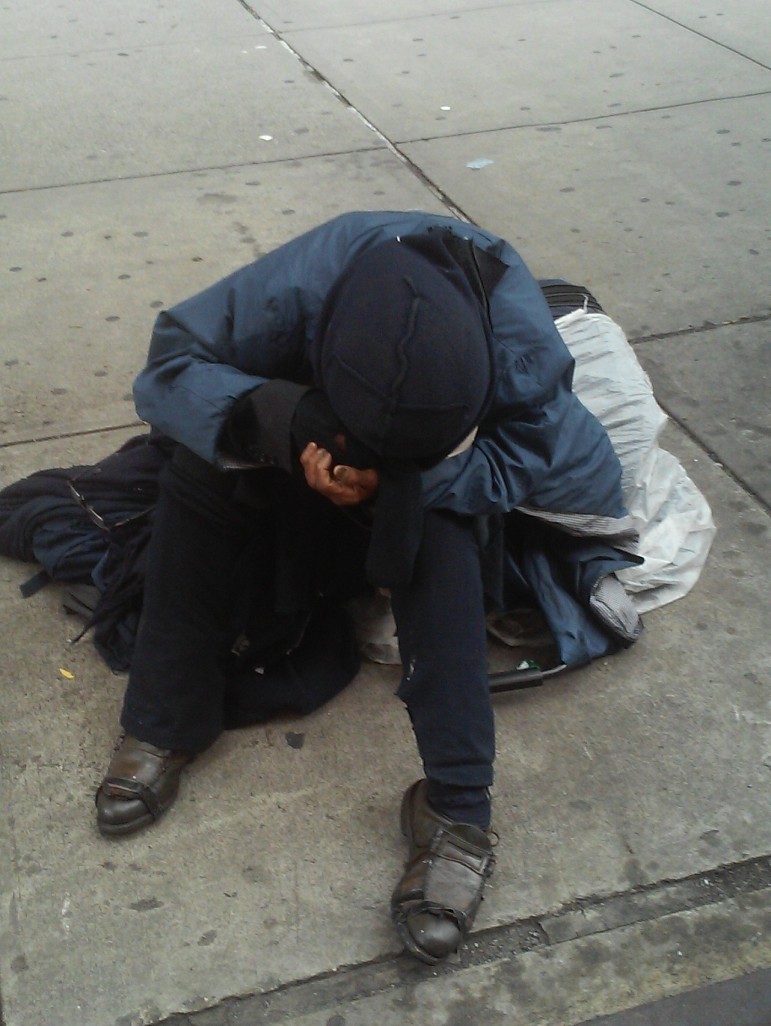
Gerard Flynn
A homeless woman on 34th Street. Stereotypes about homelessness confuse the discussion about the extent of the problem.
He never gave his name but did say that he was a hired hand with a traveling carnival over six weeks ago before getting fired during a dispute about contested wages.
In his first unsheltered week he was rudely awoken in the wee hours by a violent kick to the guts, right across the street from the Pennsylvania Hotel, immobilizing him and allowing his assailant to steal just about all of his belongings.
He was left with just about the shirt on his back and a night gown as his bedsheet. He had just that morning read another article from the New York Post probing the street homeless crisis, which the tabloid is claiming to be at explosive levels.
The Post‘s effort is drawing fire from homeless advocates, including Mary Brosnahan, president of the Coalition for the Homeless. She doubts the paper is trying to help the cause. She does agree, however, that street numbers are higher—if not quite the explosion the Post is claiming—and that the mayor needs to come right out and say so.
“The numbers are up, and they are not just people who are troublemakers. Thousands are suffering on our streets. I have yet to meet anyone who thinks the numbers are down,” she says.
By what margin the numbers of street homeless are up, however, neither Brosnahan nor anyone else can say with certainty. While the number of homeless in city shelters is known precisely, the city’s estimate of the street homeless population relies on a one-night-a-year survey conducted in January, called the Homeless Outreach Population Estimate, or HOPE, a federally-backed initiative carried out by the Department of Homeless Services.
The figure for this year doesn’t look all that bad, the mayor is saying: 3,182, actually dipping a couple hundred on last year. De Blasio recently told an audience in Brooklyn that whatever the media is saying about the number of homeless, the opposite is true. “The actual numbers, thank God, suggest that the reality is a little different — that the actual number of street homeless has gone down a bit,” he said.
But advocates aren’t reassured. “Going out on the coldest night of the year to count heads is preposterous,” Brosnahan says. “[Survey teams] are precluded from going into subway trains. Right there, imagine how many you are missing.”
This year, Picture the Homeless (PTH) sent volunteers out on the street during the DHS’s sweep on a freezing February night who found themselves passed over by DHS volunteers doing the counting.
“A lot of our members acted as decoys and were never approached by counters. And this is on the coldest night of the year when they are sleeping on park benches,” PTH board member William Burnett says.
To stem the homeless tide, Brosnahan wants the city and state to cooperate more and build thousands of units of supportive housing. The mayor must also do more to reverse the damage done under Mayor Bloomberg, advocates say, when the homeless population soared by more than 20,000, as NYCHA programs housing the homeless were scaled back and rental subsidies were phased out. De Blasio has taken steps to reverse both policies. But the mayor would help more if he admits ” the numbers are up,” Brosnahan says.
Though he has worked with the homeless a long time, Nicki Price, an organizer with Picture the Homeless, is also a skeptic of the HOPE numbers, but points the finger back to Bloomberg.
“They don’t want you to know how bad the problem is. The city has not been dealing with the homeless problem for many administrations,” he says. “They should be doing a street homeless count now. Why aren’t they?”
Burnett, who has been homeless on-and-off since the 1990s, believes that “Unless you start counting people on the street when they are out there, it’s hard to say if that number has increased or decreased.”
“I don’t see anything like what the New York Post is spreading,” he says. “It’s not relying on data either, but hyperbole.”
One way to improve the HOPE system, he says, is for survey organizers to stop making “assumptions about who the homeless are.” The volunteers should not be told that the homeless wear tattered clothes and are unclean. “That’s typically not the case,” he says. “Most homeless don’t dress like that.”
City Limits’ coverage of housing policy is supported by the Charles H. Revson Foundation.
* * * *









One thought on “Reports of Homeless Surge Confront Limitations of City Stats”
The organizations that actually help provide housing to formerly homeless people are “mandated” to provide regular reports about the people they serve in order to receive funding from government agencies like HUD. That’s fine, BUT what’s horrible is that they’re promoting stigmatizing stereotypes about these people, and the demographics are skewed by the most popular profile in use, which is MICA: Mentally Ill, Chemically Abusing. NOT all homeless people are mentally ill, alcoholic or drug addicts. Some are merely poor. Others have other health issues that DON’T include self-inflicted misery (addictions). And what’s worse is the absolutely pernicious requirement by the professional networking agencies (like http://www.nychomeless.com/) to refer to their formerly homeless clients as CHRONICALLY homeless. The reality is that many people are NOT chronically homeless; some have experienced catastrophic events in their lives like messy divorces where the 18B lawyers appointed by the courts did nothing while they were left without spousal support, access to their children, and worse – or medical crises that left them penniless – or losing a job when they’d been living paycheck to paycheck, and they find themselves homeless ONCE when they’ve never been homeless before in their lives.
The system in place right now that’s supposed to help people is so broken on so many levels it’s obscene.